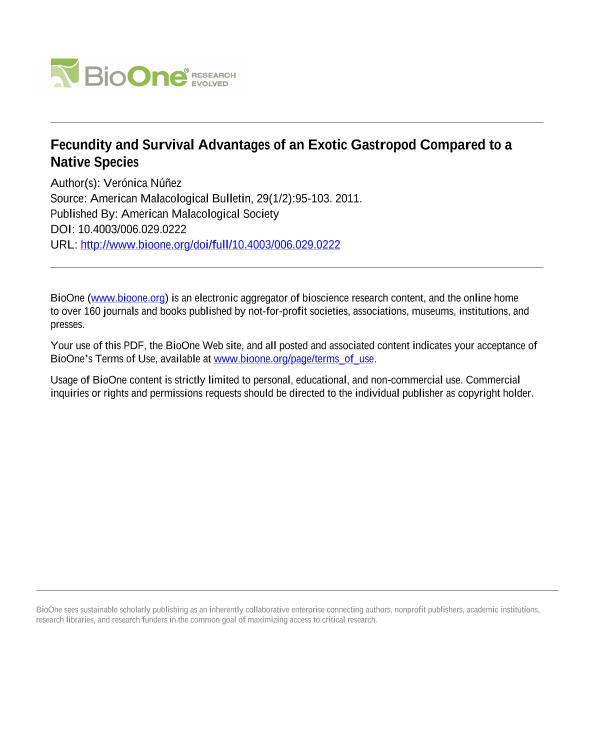Mostrar el registro sencillo del ítem
dc.contributor.author
Nuñez, Maria Veronica

dc.date.available
2020-05-08T16:17:54Z
dc.date.issued
2011-03
dc.identifier.citation
Nuñez, Maria Veronica; Fecundity and Survival Advantages of an Exotic Gastropod Compared to a Native Species; American Malacological Society; American Malacological Bulletin; 29; 1-2; 3-2011; 95-103
dc.identifier.issn
0740-2783
dc.identifier.uri
http://hdl.handle.net/11336/104629
dc.description.abstract
In Argentina the exotic snail Physa acuta Draparnaud, 1805 is predominant in environments previously inhabited by the native species Stenophysa marmorata Guilding, 1828, raising the question of whether this could have occurred because of differences in survival or reproductive strategies. To analyze the life cycle of these two species, I used the horizontal—life-table method and considered the number and proportion of viable of eggs per oviposition. Although both species suffered a high degree of mortality during the first weeks after oviposition, both the rate and the force of mortality was much greater during the reproductive period, so that the survival curve was not as markedly concave as with other gastropods. Physa acuta survived longer than S. marmorata, began its reproductive period earlier, and had a longer and more continuous reproductive stage. The number of ovipositions per snail was not different between the two species; but since the mean number of eggs per oviposition was higher in P. acuta, fecundity was likewise higher. The increase in fecundity was accompanied by an enhancement of the mortality rate in S. marmorata. The percentage of viable eggs was higher in P. acuta than in S. marmorata, but fecundity increased with age in both species. Life expectancy, reproductive value, and net reproductive rate were higher in P. acuta. The success of the exotic species P. acuta in the native habitat of S. marmorata could be explained in part by the former's earlier sexual maturation, higher reproductive potential, and greater longevity. Further field and laboratory studies are needed to demonstrate the existence of interspecific competition between these two gastropods.
dc.format
application/pdf
dc.language.iso
eng
dc.publisher
American Malacological Society

dc.rights
info:eu-repo/semantics/openAccess
dc.rights.uri
https://creativecommons.org/licenses/by-nc-sa/2.5/ar/
dc.subject
LIFE CYCLE
dc.subject
PHYSIDAE
dc.subject
REPRODUCTION
dc.subject
SURVIVORSHIP
dc.subject
INTRODUCED SPECIES
dc.subject.classification
Ecología

dc.subject.classification
Ciencias Biológicas

dc.subject.classification
CIENCIAS NATURALES Y EXACTAS

dc.title
Fecundity and Survival Advantages of an Exotic Gastropod Compared to a Native Species
dc.type
info:eu-repo/semantics/article
dc.type
info:ar-repo/semantics/artículo
dc.type
info:eu-repo/semantics/publishedVersion
dc.date.updated
2020-05-04T19:53:55Z
dc.journal.volume
29
dc.journal.number
1-2
dc.journal.pagination
95-103
dc.journal.pais
Estados Unidos

dc.journal.ciudad
Filadelfia
dc.description.fil
Fil: Nuñez, Maria Veronica. Consejo Nacional de Investigaciones Científicas y Técnicas. Centro Científico Tecnológico Conicet - La Plata; Argentina. Universidad Nacional de La Plata. Facultad de Ciencias Naturales y Museo. División Zoología Invertebrados; Argentina
dc.journal.title
American Malacological Bulletin

dc.relation.alternativeid
info:eu-repo/semantics/altIdentifier/url/https://bioone.org/journals/american-malacological-bulletin/volume-29/issue-1_2f_2/006.029.0222/Fecundity-and-Survival-Advantages-of-an-Exotic-Gastropod-Compared-to/10.4003/006.029.0222.short
dc.relation.alternativeid
info:eu-repo/semantics/altIdentifier/doi/http://dx.doi.org/10.4003/006.029.0222
Archivos asociados
